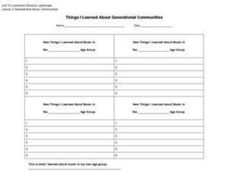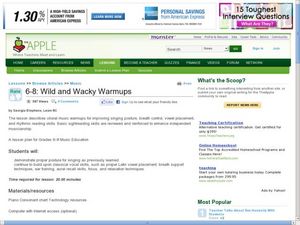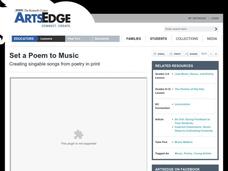Peter Nagy
Virtuoso Piano Free 3
This may be as close to playing a piano as it is possible to get without actually having a physical instrument in the class. Learn the names and sounds of keys, play a solo or a duet, and practice scales or any song you'd like–all for free!
Curated OER
A Shape-Note Singing Lesson
Students discover the shape-note method of singing. In this reading and notating music lesson plan, students learn the four shapes of the shape-note method and the tradition of Sacred Harp singers. Students sing the shapes of "Yankee...
Curated OER
Global Music Lesson Plans: Britten and Japan – Japan and the UK
Students explore the links between Japanese and British culture. In this Japanese music lesson, students listen to their instructor present a lecture regarding Gagaku music and then perform "Te Lucis Ante Terminum" with Japanese...
Curated OER
Pentatonic Scale- Chinese Music
In this pentatonic scale instructional activity, students review the meaning of scale, notes, and flats. They read about the notes used in the Chinese pentatonic scale and learn how to name them. There are no questions associated with...
Curated OER
Things I Learned About Generational Communities
In this generational music communities worksheet, students note the things they learned about music styles that appeal to people in certain age groups.
Curated OER
How Do I Measure Up? (Intermediate)
Fifth graders compare the relationship between meter in music and measurement in math. They practice sightreading music by determining the number of beats per measure, clapping and counting the rhythm.
Curated OER
Music in Nature
Students research the Incan civilization. For this Incan civilization lesson, students study the geography of the Andes mountains and play an Andean siku. Students discuss how the sounds of nature influenced their musical piece.
Curated OER
American Music Genres
Students research and listen to a variety of American music genres and create a written comparison between three of the styles.
Curated OER
Compas-- Modern Popular Music of Haiti
In this music instructional activity, students discover facts about the musical styles and rhythms of Haiti. Students learn about Compas and Voodoo music and answer 4 questions. Note: Punctuation is missing from one of the questions.
Curated OER
Dance: African Drumming
Students evaluate the messages in music. In this communication through music lesson, students listen to various musical selections and determine the message being conveyed in the song. Then, students create their own message as they...
Curated OER
Create a Composition
Students select an instrument and create a musical composition. In this musical composition lesson, students invent an original piece of music that is 16 measures long. Students hum and record their pieces.
Curated OER
Wild and Wacky Warmups
Students explore vocal music techniques. In this vocal music lesson, students follow a series of warmup exercises modeled by the teacher, then participate in specific breathing and vocalizing exercises.
Curated OER
Performing Gospel Music (Keyboard or Piano)
In this music worksheet, learners learn to play a piece of gospel music called "Siyahamba" on the piano or keyboard. Students examine the musical notes written on the staffs and read the helpful hits in the margins. Piano knowledge is...
Smithsonian Institution
Affirmation, Assimilation, and Acculturation: Middle School
Latin American culture is deeply embedded in American culture as a whole. From the Latin rock scene in San Francisco to the hip-hop world of New York, Latin American artists have influenced every genre of modern music. Learn about the...
Johnny Mercer Foundation
Project-Based Songwriting
Project-based learning in a music theory class? Take note. Young songwriters compose, record, copyright, and promote their original songs. They even design their own CD cover.
General Motors Corporation
Jazz
Over the history of the world, music has been at the heart of some of the greatest social and political movements. Scholars discover their musical roots as they dive into the sounds and emotions of renowned jazz players. They see how...
K20 LEARN
Diggin' Deeper - Poetry Made Relevant: Poetry And Poetic Devices
What do Beethoven, Bob Dylan, and Pharrell all have in common? Works by these three musicians are used to launch a study of poetry. Class members listen to passages from the music and craft a quick write about how the music makes them...
K20 LEARN
Rikki-Tikki-Types of Sentences: Indicative, Imperative, Interrogative Mood
Rudyard Kipling's "Rikki-Tikki-Tavi" and a song from the musical "Hamilton" allow middle schoolers to practice using punctuation to indicate whether sentences are indicative, imperative, or interrogative.
Curated OER
Creating Musical Notation
In this creative music activity from Scientific American, students learn about musical notation and then design their own notations. Great web resource links are alsp provided
Curated OER
Tuning the World One Note at a Time
Young scholars investigate music around the world and work with a photographer to understand elements of photography. In this photography lesson, students visit a dance hall and interview the dancers. Young scholars gather ideas...
Curated OER
Making a Musical Instrument
Students determine how music is produced through sound waves and how instruments produce music differently than others. They construct flutes out of straws and explore how to adjust the sound.
Curated OER
Set a Poem to Music
Students consider the role of rhythm and meter in poetry. In this integrated arts lesson, students discuss the attributes of poetry and use their music skills to set picture book poetry to music by creating "singable" poems.
Curated OER
TE Lesson: Energy Transfer in Musical Instruments
Students study concepts of energy and energy transfer. They look at how these concepts apply to musical instruments. They study the law of conservation of energy. They use the concepts studied in the lesson plan to design a musical...
Curated OER
Notating a Rainy Day
Young singers learn how to notate the rhythms and melodies of a familiar song using Kodaly hand signals and manipulatives. Individuals then create their own compositions and sing them using Kodaly notation.

























